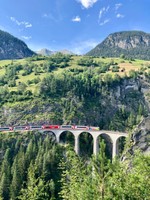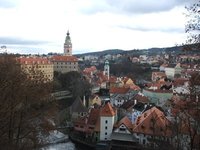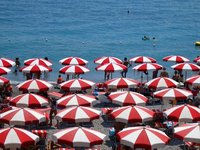Europe
Travel Guide Europe
Introduction
Europe may be the world's second smallest continent, but it's a place of extreme importance, both in today's world and throughout history. The grand empires of Ancient Greece and Ancient Rome were the early signposts, but the centuries since that time have seen the rise and fall of more great powers. Perhaps the era of Europe's greatest dominance began several centuries ago, as European nations set out to explore, colonise, and "Westernise" the rest of the world. Even now, decades after the official end of colonisation, Europe enjoys the power birthed and fostered during previous centuries.
Europe may not be large, but it is unique and diverse with more than 50 sovereign states, several dependent territories, and even more languages, historical regions and cultures. Compare the wealth and power of Western Europe with the comparatively underdeveloped Eastern Europe, although even those countries are catching up in the 21st century. Enjoy the warmth of Southern Europe, take in breathtaking winter scenery in Northern Europe or discover beautiful old towns of Central Europe. Witness some of the world's most modern buildings in some of the world's oldest cities.
Geography
Boundaries
Europe is situated in the western part of Eurasia. It is bounded by the Atlantic Ocean to the west, the Mediterranean Sea to the south and the Arctic Ocean to the north. The eastern boundary with Asia and the Middle East is more tenuous. While there are several competing definitions, the most common one uses the Ural Mountains, the Caspian Sea and the Caucasus as the eastern border. Russia is partially in Europe and partially in Asia.
Turkey and the island of Greenland do not technically belong in Europe when defined as a continent, although geographically a small part of Turkey west of the Bosporus is located in Europe. Culturally, Turkey belongs to Asia. For travelling purposes however, this country is sometimes included in guidebooks covering Europe.
Physical geography

Landwasserviaduct, Filisur
© Utrecht
Despite being one of the smallest continents, Europe's landscape boasts an incredibly varied terrain. From the Baltic Mountains and Dinaric Alps on the Balkan, the land rises as you go north, with the Carpathian Mountains stretching from Romania to Slovakia and the Alps jutting up in central Europe. The Apennines extend south from the Alps into the Italian peninsula, while the Pyrenees separate France and Spain. Further north, the landscape is less dramatic, from the lowlands in the northwest of Europe to the vast East European Plain. In Scandinavia, the terrain once again becomes mountainous, as the Scandinavian Mountains stretch from the south to the north and Norway's coast is marked by impressive fjords. However the highest peaks of Europe can be found in the Caucasus, the mountains separating Russia and Georgia. Mount Elbrus, at 5,642 metres, is the highest mountain in Europe.
There are several major rivers in Europe, including the Volga in Russia and the Danube in Central and Eastern Europe. The Rhine, Elbe, Loire, Rhône and Seine are other famous rivers in Europe, all of which are found in Western and Central Europe. In northern Italy, the Po is the most important waterway, and on the Iberian Peninsula the Tagus and the Guadalquivir.
Regions of Europe
| Central Europe | Austria, Czech Republic, Germany, Hungary, Liechtenstein, Poland, Slovakia, Slovenia, Switzerland |
| Eastern Europe | Armenia, Azerbaijan, Belarus, Bulgaria, Georgia, Moldova, Romania, Russia (partially only), Ukraine |
| Northern Europe | Denmark (includes the Faroe Islands and Greenland), Estonia, Finland (includes Åland), Iceland, Latvia, Lithuania, Norway (includes Jan Mayen and Svalbard), Sweden |
| Southern Europe | Albania, Andorra, Bosnia and Herzegovina, Croatia, Cyprus, Gibraltar (UK), Greece, Italy, Kosovo, Macedonia, Malta, Montenegro, Portugal (includes Azores and Madeira), San Marino, Serbia, Spain (includes the Canary Islands), Turkey (partially only), Vatican City |
| Western Europe | Belgium, France, Guernsey, Ireland, Isle of Man, Jersey, Luxembourg, Monaco, Netherlands, United Kingdom (England, Scotland, Wales, Northern Ireland) |
Several other sub-groupings exist within Europe, including the Benelux (Netherlands, Belgium, Luxemburg) and Scandinavia (Denmark, Norway, Sweden, Iceland, but not Finland!). The Scandinavian countries with their dependent territories and Finland are collectively referred to as the Nordic countries. Estonia, Latvia and Lithuania are called the Baltic states, or simply the Baltics.
Countries, Dependencies and Territories

Cesky Krumlove
© sarahlee
For overseas dependent territories belonging to European countries, please see the following articles: Overseas Territories France, Overseas Territories Norway and Overseas Territories United Kingdom.
Sights and Activities

Historic Stockholm
© Peter
Major cities
Some of the world's most important and fun cities to visit are found in Europe. The list can go on and on. Each city is a symbol of Europe, marrying modern industry with a long, proud heritage. Here is a short list of some of the most famous cities in Europe:
- Amsterdam, the Netherlands
- Athens, Greece
- Barcelona, Spain
- Berlin, Germany
- Brussels, Belgium
- Budapest, Hungary
- Copenhagen, Denmark
- Edinburgh, Scotland (UK)
- Hamburg, Germany
- Lisbon, Portugal
- London, England (UK)
- Madrid, Spain
- Moscow, Russia
- Paris, France
- Prague, Czechia
- Rome, Italy
- St. Petersburg, Russia
- Stockholm, Sweden
- Venice, Italy
- Vienna, Austria
- Warsaw, Poland
- Zürich, Switzerland
Landmarks
See also: Famous Landmarks
- Norwegian Fjords are vast and beautiful. Formed over thousands of years, they are identified by their huge steep sides and cliffs.
- The Alps are great for skiing, summer hikes and rock climbing.
- The Eiffel Tower is located in Paris, France. It is one of the most popular landmarks in Europe and one of the most recognisable structures in the whole world.
- Big Ben and Tower Bridge in London are historical marvels of old architecture and British craftsmanship.
- The Icelandic geysirs are some of the most amazing geothermal spots in the world owing its distinctiveness to volcanic activity which is rareley seen elsewhere in Europe.
- Alhambra in Granada in Andalusia, southern Spain is the example of Mudejar architecture.
- Italian cities like Venice, Florence, Pisa and Siena can truly impress anyone.
- Monaco is a great place for gambling and high end beaches. It is a getaway destination for multi millionaires to sit in the sunshine on luxurious yachts.
- Auschwitz, a World War II concentration camp in Poland, offers a chilling reminder of recent European history. It has become a symbolic landmark to Nazi atrocities committed during the reign of Hitler and tragedy of countries conquered by them during the Second World War.
- Hermitage, in St. Petersburg, is the place for all sorts of art.
- The Colosseum in Rome is the ancient gladiatorial arena of the Roman empire. It is one of the largest and most impressive remnants of this ancient civilization.
- Acropolis in Athens is one of the most famous Greek ruins and also stands as the epitome and symbol of the ancient greeks.
- Jungfrau Railway and the Jungfrau-Aletsch-Bietschhorn World Heritage Site in Switzerland
- Dubrovnik - Its Old Town is one of Croatia's greatest tourist attractions and a UNESCO World Heritage Site.
- Buckingham Palace is the official London residence of the British monarch. It is wildly popular with tourists.
- Charles Bridge in Prague and the castle are stunning examples of Medieval architecture. Prague's thousand year history has seen it develop into a multicultural capital.
- The Tower of Pisa, or as it is more commonly known, the leaning tower of Pisa, is the freestanding bell tower of the cathedral within the city of Pisa, Italy. Due to a design flaw this buildings oddity has now become a world famous landmark and popular attraction for tourists.
- Stonehenge in southern England is a mysterious stone circle dating back many thousands of years. Its purpose and origins remain a mystery although archaeologists have many theories.
- The Arc de Triomphe is another Parisian landmark which commemorates those who died during the French revolution and the subsequent wars of Napoleon.
- The Palace of Versailles is a grand and expansive symbol of pre-revolution France and monarchist rule. The huge historical building is complimented by the vast and well maintained grounds.
Beaches

Amalfi Coast
© robjwood
The warm Mediterranean at the southern end of Europe affords some of the world's most popular beaches. Countries like Greece, Italy, Spain (including the Canary Islands) and France receive many visitors each year in search of a tan. Over the past decade, Croatia has also become popular as a beach destination, thanks to its ideal location on the Adriatic Sea. Beaches in Cornwall, England, offer some of the best surfing experiences available in Europe. They are a popular destination for surfers from around the world.
Churches
As the historical centre of Christianity, Europe is home to some of the world's most amazing churches:
- La Sagrada Familia is a Roman Catholic cathedral in Barcelona that has been under construction since 1882. It is one of the most impressive buildings the in the world and has an estimated completion date of 2026.
- St. Basil’s Cathedral in Moscow is unlike any other cathedral in Europe. Its unique appearance has become an integral part of the Moscow cityscape and the building was almost destroyed during Stalin's reign in power.
- One of the largest cathedrals in the world is Cologne Cathedral in Germany. It is the second tallest church in the the world, surpassed only by Ulm Cathedral, which is also in Germany.
- Basilica di Santa Maria del Fiore in Florence was once the largest cathedrals in Europe with a capacity of 30,000.
- The Vatican City in Rome is the world capital of Catholicism. It is classed as its own sovereign city state and has many churches and structures within its walls. The largest and most famous of which is St. Peter's Basilica which, although technically not a cathedral, has the largest interior of any Christian church in the world. It is considered one of the most important Christian temples and it houses the tomb of Saint Peter.
Traditional towns
There is a plenty of historic towns in many countries in Europe. Many of them have ancient roots as still present styles from that era (Kos and Rodos in Greece, remains of Roman Dacia in Romania, towns on the Amber Road from the area of the Baltic Sea to Italy, Aquino in Italy, Merida in Spain). Many famous medieval towns have also ancient beginnings but mainly medieval monuments have survived to this day (Roskilde in Denmark, Sandomierz in Poland). Well-preserved towns from the ancient era and the Middle Ages usually have many monuments from later times as Nancy in France, Dubrovnik in Croatia, Presov in Slovakia, Podebrady in Czech Republic, Kazimierz Dolny in Poland, Vác in Hungary, Breda in the Netherlands, Cambridge in UK and Jena in Germany.
Museums
Europe has many famous museums. Art lovers could spend months in Europe and it still wouldn't be enough time to see everything. Amongst the most famous museums, are both the Tate Museums and the British Museum in London, the Prado and the Reina Sofia in Madrid, the Pergamon Museum in Berlin, the Van Gogh Museum in Amsterdam, the Academia in Florence, with the statue of David and of course maybe the best known of them all: the Louvre in Paris, where you can find the Mona Lisa. But also some lesser known and smaller museums can be worth a visit. In many cities there is some kind of a city- or town museum, that can tell you more about the local history.
Skiing
In Alpine countries such as France, Switzerland and Austria, skiing is an immensely popular activity. Further north, the Scandinavian countries of Norway, Sweden and Finland also offer skiing opportunities, while some smaller towns in Eastern Europe, in the Caucasus, and the Sierra Nevada in the south of Spain, are lesser-known skiing destinations.
Getting There and Around
Located at the crossroads between all continents except Oceania, Europe has a wide range of flight connections. Numerous airlines serve hundreds of destinations on a daily basis, especially to North America and the southern and eastern parts of Asia. But there are direct flights to the Middle East, Caribbean, South America and Africa as well. Only Australia and New Zealand, and the Pacific Islands, basically require a change of planes. By ferry, Europe can be reached from North Africa (both Morocco and Tunisia have regular ferries) and popular overland routes include those from Asia, either by Trans-Siberian Railway from China and Mongolia through Russia, or from India and Iran to Turkey. Other routes to get to Turkey run from Egypt via Jordan and Syria. For option to get around in Europe by ferry, check the European ferries article.
Best Time to Visit
By far the best time for most of Europe is the summer season, which lasts from May to September. July and August can be very busy in many countries, and southern Europe can be very hot in some places like Andalusia, Sicily and the Greek islands. If you don't like cold weather, this is by far the best time to visit the northern parts of the continent. Expect 24 hours of daylight though in the extreme north during June and July.
Some areas focus on wintersports, like parts of Norway, northern Finland and the Alps. The best time for those activities obviously is wintertime from December to March. If you are not into beaches or skiing, travelling around Europe is great in Spring and Autumn, roughly April/May and September/October respectively. Prices are much lower, you'll rarely experience crowds and with flowers and leaves at their best colours, it just adds to the experience.
Learning European Languages
These language phrasebooks were created by Travellerspoint members to help travellers pick up some basic phrases, grammar and pronunciation skills before their trip:
- Dutch phrasebook
- German phrasebook
- Italian phrasebook
- Portuguese phrasebook
- Russian phrasebook
- Spanish phrasebook
- Turkish phrasebook
Find out about contributing to or starting a new phrasebook on our project page: Project:Language phrasebooks.
Contributors
 Utrecht (57%)
Utrecht (57%)
from https://utrecht.travellerspoint.com AMX (18%)
AMX (18%)
from Seeing Europe
as well as Hien (8%), Frodo42 (4%), dr.pepper (3%), Herr Bert (2%), Lavafalls (2%), hasbeen (2%), SZ (2%), mjc410 (1%), Peter (1%), PeteB (<1%), (<1%)
Europe Travel Helpers

leics2
Ask leics2 a question about EuropeHave done a lot of travelling throughout Europe, almost always using public transport and particularly focusing on archaeological and historical sites. Happy to help wherever I can.

Utrecht
Ask Utrecht a question about EuropeLiving in the Netherlands, I travelled extensively across many parts of Europe, from the off the beaten track Faroe Islands to glitzy Paris or ancient Rome. Also travelled a lot in Eastern Europe, including unusual ones like Moldova, Kosovo and the Caucasus countries. So if you have questions about Scandinavia, the Mediterranean, the Alps, British Isles or many cities, please ask.

iscanlon65
Ask iscanlon65 a question about Europefrom there

Freddi Woomba
Ask Freddi Woomba a question about EuropeSimply.. I have been travelling around Europe for more than 2 years. I have worked under the table in 4 countries as an 'illegal immigrant' lol. And I have now managed to walk across nearly 3000 km . There is a small amount of knowledge on my blog :)
http://stevenhunter-freddiwoomba.tumblr.com/
travelfrosch
Ask travelfrosch a question about EuropeHappy to help, especially with logistics and transportation questions.
This is version 195. Last edited at 7:45 on Jul 22, 20 by Utrecht. 1739 articles link to this page.

Except where otherwise noted, content of this article is licensed under a Creative Commons Attribution-ShareAlike 3.0 License


